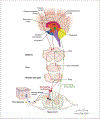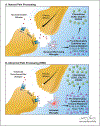Neuroimmune Interactions in Pain and Stress: An Interdisciplinary Approach
- PMID: 32441204
- PMCID: PMC10257788
- DOI: 10.1177/1073858420914747
Neuroimmune Interactions in Pain and Stress: An Interdisciplinary Approach
Abstract
Mounting evidence indicates that disruptions in bidirectional communication pathways between the central nervous system (CNS) and peripheral immune system underlie the etiology of pathologic pain conditions. The purpose of this review is to focus on the cross-talk between these two systems in mediating nociceptive circuitry under various conditions, including nervous system disorders. Elevated and prolonged proinflammatory signaling in the CNS is argued to play a role in psychiatric illnesses and chronic pain states. Here we review current research on the dynamic interplay between altered nociceptive mechanisms, both peripheral and central, and physiological and behavioral changes associated with CNS disorders.
Keywords: neuroimmunology; pain; stress.
Conflict of interest statement
Declaration of Conflicting Interests
The author(s) declared no potential conflicts of interest with respect to the research, authorship, and/or publication of this article.
Figures






References
-
- Alexander GM, van Rijn MA, van Hilten JJ, Perreault MJ, Schwartzman RJ. 2005. Changes in cerebrospinal fluid levels of pro-inflammatory cytokines in CRPS. Pain 116(3):213–9. - PubMed
-
- Ashkinazi IY, Vershinina EA. 1999. Pain sensitivity in chronic psychoemotional stress in humans. Neurosci Behav Physiol 29(3):333–7. - PubMed
Publication types
MeSH terms
Substances
Grants and funding
LinkOut - more resources
Full Text Sources
Medical

